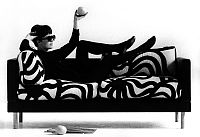Marimekko: Fabrics, Fashion, Arhitecture
1st July - 18th October 2009 (prolonged to 3rd January 2010)
Visiting exhibition
 Marimekko was established in 1951 in Helsinki, Finland, the brainchild of the charismatic and visionary Armi Ratia. The company's name, which literally translates as "Mary dress," has various interpretations, reflecting the complex associations and dualities that define the Marimekko aesthetic – national and international, traditional and modern, rural and urban, natural and technological. The introduction of Marimekko in the 1950s was a design sensation that swept across the international scene, and the company became one of the premiere furnishing, textile and fashion enterprises of the post-war era and beyond. The striking, large-scale fabric patterns and unconventional ready-to-wear dresses brought colour and informality to an otherwise self-conscious design and fashion world.
Marimekko was established in 1951 in Helsinki, Finland, the brainchild of the charismatic and visionary Armi Ratia. The company's name, which literally translates as "Mary dress," has various interpretations, reflecting the complex associations and dualities that define the Marimekko aesthetic – national and international, traditional and modern, rural and urban, natural and technological. The introduction of Marimekko in the 1950s was a design sensation that swept across the international scene, and the company became one of the premiere furnishing, textile and fashion enterprises of the post-war era and beyond. The striking, large-scale fabric patterns and unconventional ready-to-wear dresses brought colour and informality to an otherwise self-conscious design and fashion world.
Marimekko is inextricably linked to Finland, an association that was carefully devised by Armi Ratia. Products were given uniquely Finnish names, fabric patterns referenced historic decorative motifs, and dresses showed elements of traditional Finnish clothing. Throughout Marimekko's history its ideological and aesthetic choices were in the hands of women, beginning with Armi Ratia. She recruited promising young designers such as Maija Isola, Annika Rimala and Vuokko Nurmesniemi, and fostered an atmosphere of unbridled creativity. Collaborations between Ratia and the open-minded and progressive designers enabled the creation of a new lifestyle concept. Marimekko extended its production to include housewares, interiors, and architecture.
The exhibition explores over a half century of the company's history, focusing on the work of the talented designers who defined the firm's identity, tracing its sometimes turbulent ascent from a local textile print works to an internationally recognised brand.


